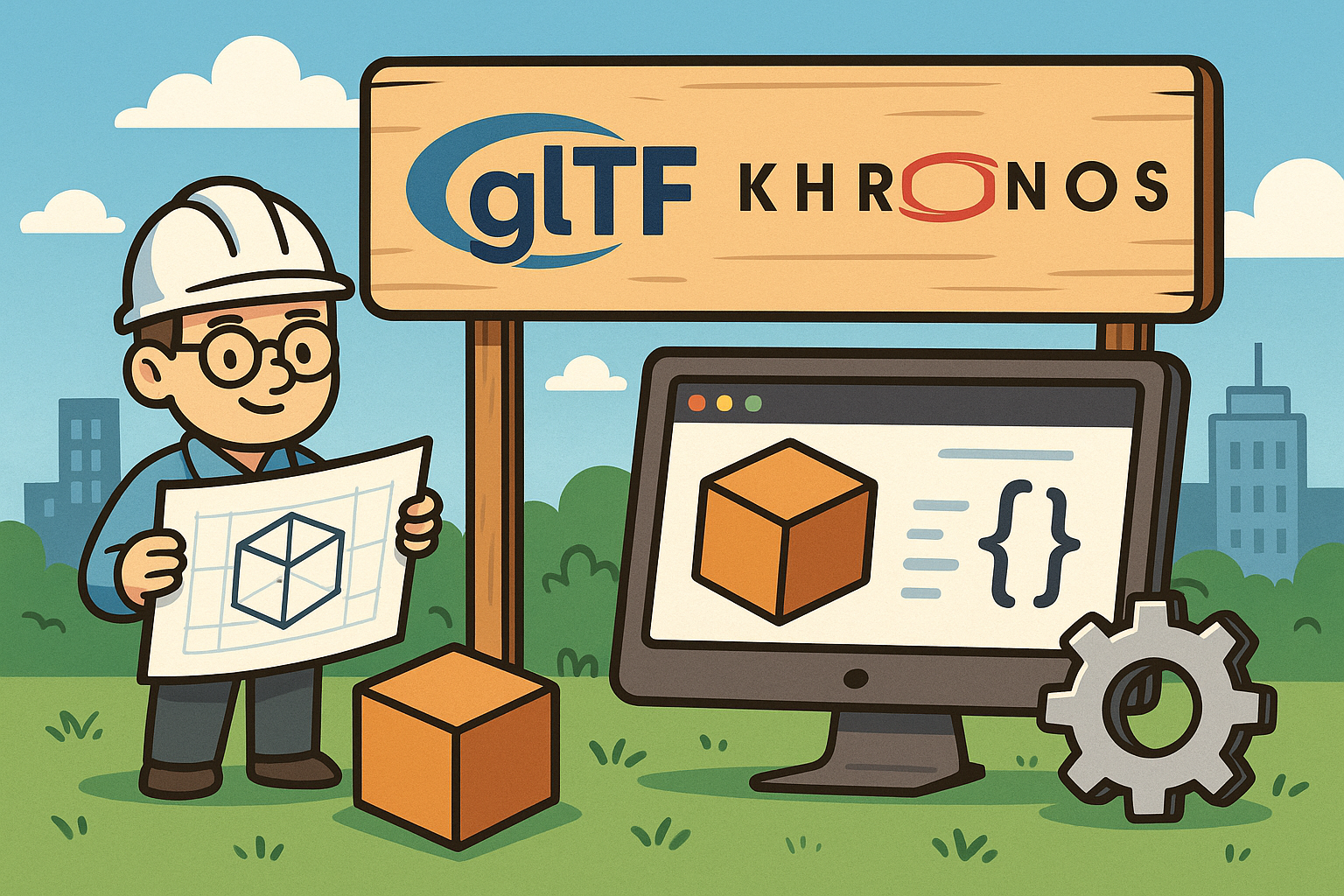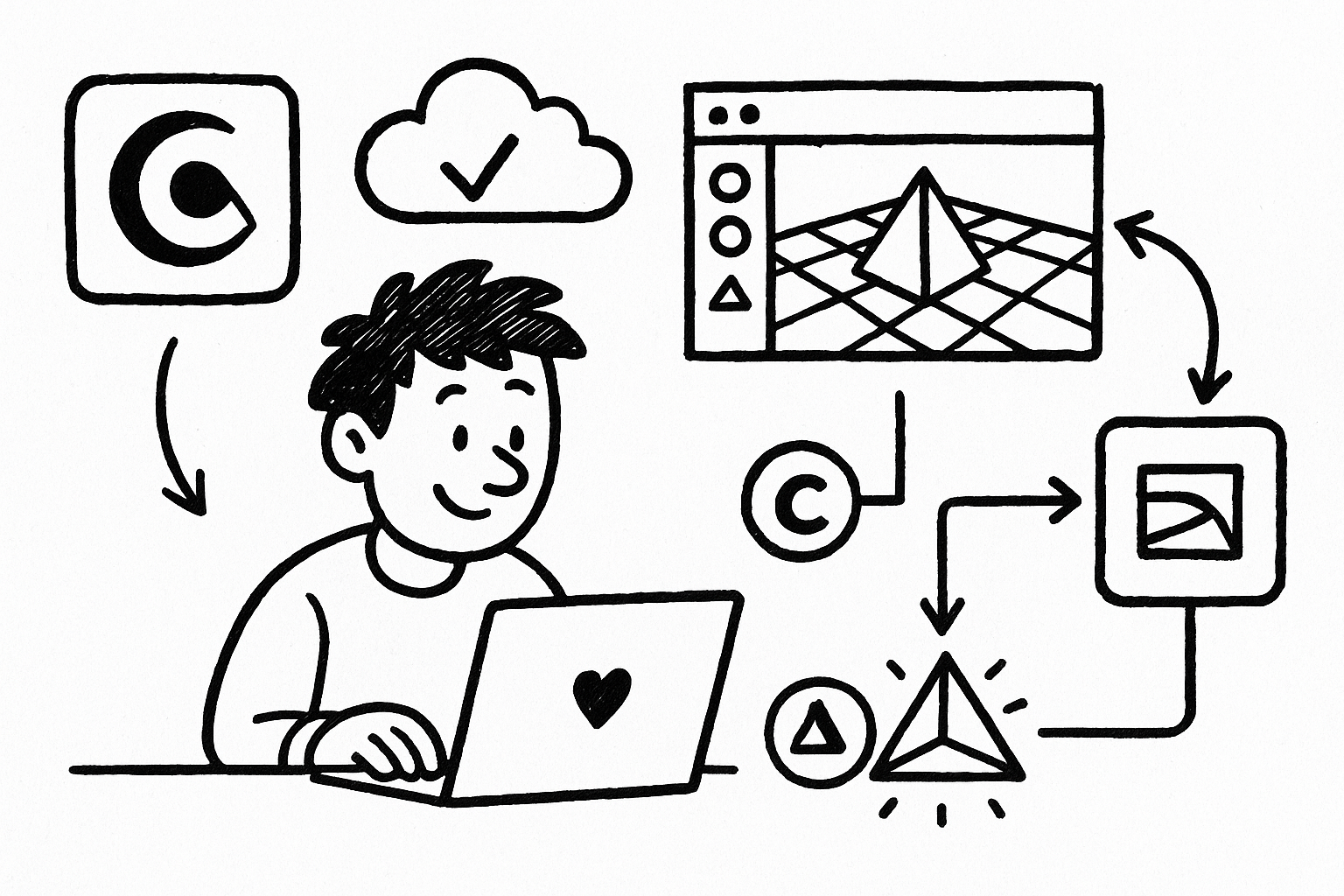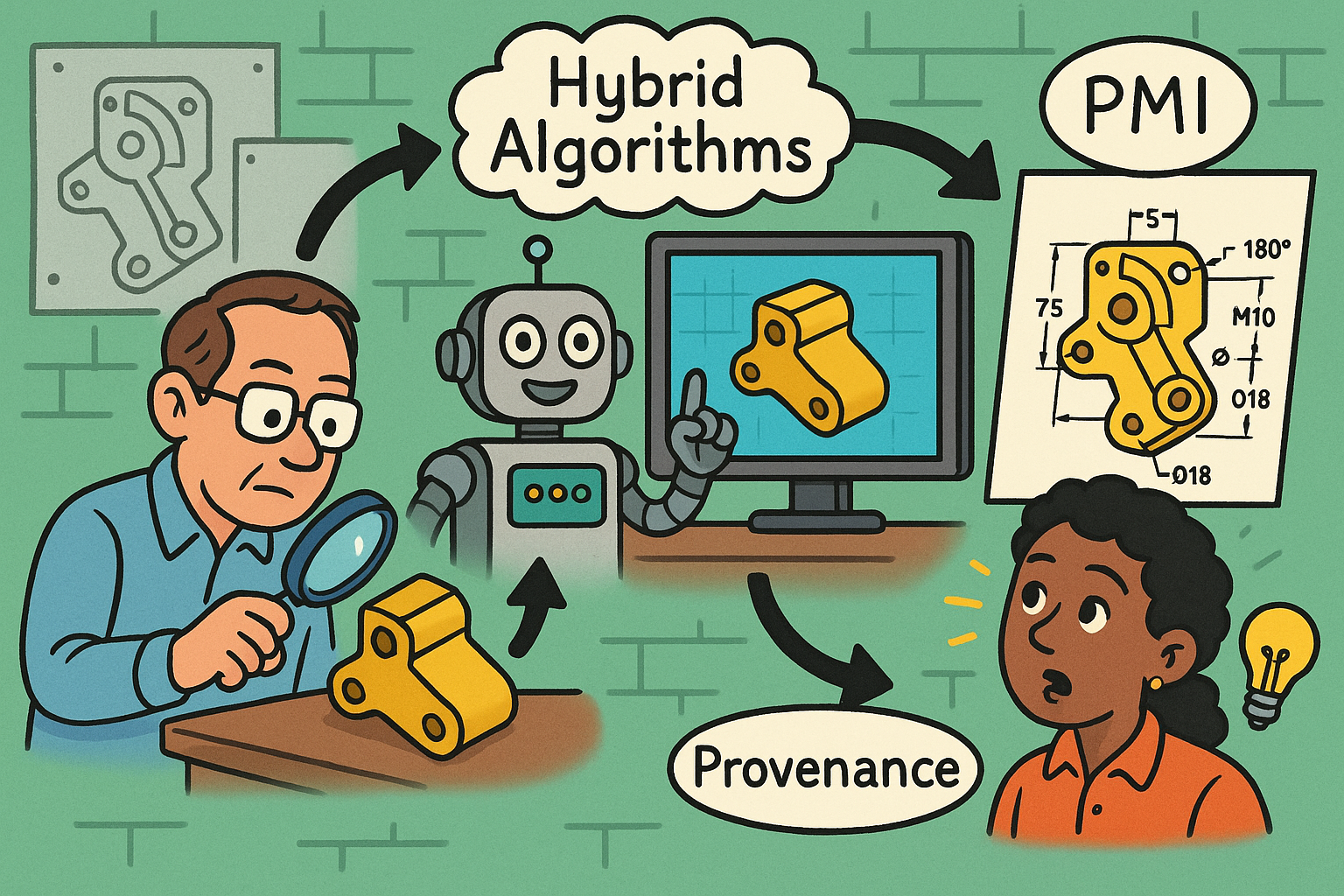Your Cart is Empty
Customer Testimonials
-
"Great customer service. The folks at Novedge were super helpful in navigating a somewhat complicated order including software upgrades and serial numbers in various stages of inactivity. They were friendly and helpful throughout the process.."
Ruben Ruckmark
"Quick & very helpful. We have been using Novedge for years and are very happy with their quick service when we need to make a purchase and excellent support resolving any issues."
Will Woodson
"Scott is the best. He reminds me about subscriptions dates, guides me in the correct direction for updates. He always responds promptly to me. He is literally the reason I continue to work with Novedge and will do so in the future."
Edward Mchugh
"Calvin Lok is “the man”. After my purchase of Sketchup 2021, he called me and provided step-by-step instructions to ease me through difficulties I was having with the setup of my new software."
Mike Borzage
Design Software History: glTF and Khronos: Architecting a Runtime-Centric, Web-Native Format for Portable 3D
October 29, 2025 13 min read


Origins and vision: Khronos’ push for portable 3D on the web
Context and motivation
When The Khronos Group set out to define glTF, the context was defined by both promise and friction. COLLADA, a Khronos interchange format championed by Sony Computer Entertainment and Autodesk studios in the 2000s, excelled as a Digital Content Creation (DCC) exchange hub, capturing rigs, animation graphs, and rich scene semantics—but it was heavy for runtime delivery. Developers had to shoulder expensive parsing, material translation, and bespoke optimization steps to get complex COLLADA scenes onto GPUs. Meanwhile, WebGL incubated between 2011 and 2014 across Google Chrome, Mozilla Firefox, Apple Safari, and Microsoft’s evolving Edge platform, proving that consumer hardware could render interactive 3D across laptops and phones. Yet mobile networks imposed bandwidth and latency ceilings, and every extra megabyte torpedoed engagement. Khronos articulated a crisp mantra: a “JPEG of 3D”—small to transmit, direct to decode, and consistent to view. The vision required a format that spoke the GPU’s language—typed arrays, interleaved buffers, and minimal state translation—while remaining engine-agnostic and open. It also required a pragmatic shading target, stabilizing on a shared Physically Based Rendering (PBR) model, so that a product looked like the same product across three.js, Babylon.js, and native engines. glTF grew from this crucible: a runtime-centric scene format optimized for download-to-draw, not a do-everything interchange omnibus.
- COLLADA remained ideal for rich authoring interchange; glTF targeted lean runtime delivery.
- Mobile constraints forced a focus on payload size, parse speed, and GPU-ready buffers.
- Consistency demanded a settled shading model and disciplined defaults.
Timeline and milestones
glTF 1.0 landed in 2015 after steady multi-vendor iteration inside Khronos working groups and GitHub issue threads. Its core ideas were already sharp: a JSON manifest describing scenes, nodes, meshes, and materials; external binary buffers for vertex and animation data; and a new single-file .glb container that embedded the JSON and binary chunks together for trivially efficient loading. The first wave proved the thesis: you could stream a compact asset, map bufferViews and accessors to WebGL typed arrays, and draw with minimal CPU work. By 2017, the group shipped glTF 2.0, elevating PBR from an extension into the core and simplifying materials to match real-time constraints. The 2.0 cycle removed the old technique stack, pushed a more straightforward baseColor/metallic-roughness pipeline, and improved animation semantics for widespread loader interoperability. Importantly, 2.0 established the extension taxonomy—KHR (cross-vendor candidate), EXT (multi-vendor experimental), and VENDOR (proprietary)—so innovation could happen without destabilizing the core. Between 2018 and 2021, the ecosystem filled in: KTX 2.0 texture pipelines with Basis Universal, geometry compression paths, PBR extensions for clearcoat and transmission, and stronger conformance tests. The specification matured in the open, with discussion spanning GitHub, Khronos Slack, and conference sessions at SIGGRAPH and GDC.
People and organizations
In standards history, determined individuals catalyze outcomes. Neil Trevett, Khronos President and long-standing champion of cross-platform graphics, helped align GPU vendors, browser teams, DCC toolmakers, and web developers around a credible scope. At Google, Brandon Jones—co-creator of WebGL’s web-friendly momentum and later a WebXR leader—advocated for formats and APIs that minimize impedance between the browser and the GPU, strongly influencing glTF’s typed-buffer spine. Patrick Cozzi at Cesium rallied early implementers in the geospatial sphere, wiring glTF into the 3D Tiles ecosystem so massive city models could stream efficiently across the web. The three.js and Babylon.js communities, with maintainers like Don McCurdy (three.js, glTF-Transform) and core contributors like David Catuhe (Babylon.js), turned the specification into lived reality—shipping loaders, test scenes, and PBR fidelity fixes. Microsoft, Sketchfab, NVIDIA, Adobe, Autodesk, and Unity contributors all pushed on the tough edges: animation interpolation details, gamma correctness, sampler defaults, and image I/O pipelines. That cross-industry coalition is what transformed glTF from proposal to practice: spec text, sample models, validation tools, conformance suites, and continuous feedback loops between creators and deployers.
Design principles
glTF’s design is governed by four principles. First, runtime-centricity: keep the core small, map directly to GPU consumption, and avoid dynamic expressions that force an engine to interpret arbitrary logic just to draw a triangle. Accessors, bufferViews, and typed arrays express geometry and animation in the memory layouts engines already use. Second, an extensible but stable core: the KHR/EXT/VENDOR model permits rapid evolution while holding the foundational schema still, enabling predictable interop and long-lived content. Third, open governance and testable conformance: specifications are public, discussions happen in the open, validators enforce the letter of the spec, and conformance targets bring viewer output into meaningful alignment. Finally, a commitment to practical shading targets: core PBR metallic-roughness provides an engine-independent baseline while allowing advanced material behaviors through well-specified extensions. Together, these principles invert the old reality: instead of shipping a do-it-all interchange that engines labor to digest, glTF ships the minimum to render reliably—while leaving latitude for innovation at the edges through extensions, tooling, and pre-processing pipelines.
Inside glTF 2.0: the technical architecture that makes it fast
Packaging and structure
glTF delivers two packaging modes to match deployment needs. The text-first .gltf form references external binary buffers and images, helping pipeline tools diff manifests and cache shared resources. The single-file .glb binary packs JSON and binary payloads into a chunked container, so a loader can memory-map the file and resolve offsets without extra network round-trips. The scene model is intentionally simple: a set of scenes, each referencing nodes arranged in a transform hierarchy; nodes can instance meshes multiple times, enabling efficient reuse of geometry for repeating props or parts. Meshes contain one or more primitives that bind attribute accessors (POSITION, NORMAL, TANGENT, TEXCOORD_n, COLOR_n, JOINTS_n, WEIGHTS_n) and index buffers to materials. Coordinates are right‑handed with Y up by common convention, and meters as the unit default—details that prevent source-of-truth drift across engines. The schema discourages polymorphic surprises: you won’t discover a runtime-expression in a material slot, only structured values and textures. That predictability keeps parsing costs low and bandwidth utilization high, whether assets are streamed to WebGL, WebGPU, or native backends.
- .gltf: JSON + external .bin and image files, good for tool diffability and CDNs.
- .glb: single-file delivery, minimal request overhead and robust for offline scenarios.
- Scene graph: deterministic transforms, straightforward instancing via node reuse.
Geometry and animation
At the heart of glTF’s efficiency is the triplet of buffers, bufferViews, and accessors. Buffers store binary data; bufferViews slice contiguous regions; accessors interpret them as typed arrays with stride, component type, and normalized flags. Engines can bind these directly as vertex buffers. Sparse accessors add delta storage so minor variations—like morph target offsets or sparse vertex attributes—avoid duplicating full arrays. Skinned meshes encode JOINTS and WEIGHTS attributes, with joints referencing a skeleton in node space; inverse bind matrices live in a buffer and animation channels drive joint transforms by TRS (translation, rotation, scale). Morph targets describe per-vertex deltas for POSITION, NORMAL, and TANGENT, blending them at runtime to add facial nuance or aeroelastic flex with minimal bandwidth. Animation is split into samplers and channels: samplers carry keyframe input/output with interpolation modes (linear, step, cubic spline), while channels target node TRS or morph weights. The separation of data and interpretation lets engines schedule updates efficiently and offload interpolation to vectorized code paths where possible.
Materials and lighting
glTF 2.0’s core material is PBR metallic‑roughness, which balances simplicity with physical plausibility. Base color can be a texture and/or factor, metallic and roughness live in a shared texture’s B and G channels, and normal, occlusion, and emissive maps occupy their respective slots. This aligns with real-time shading models in engines like Filament and Unreal while remaining portable across web engines. The extension ecosystem expands physical richness in measured increments: KHR_materials_clearcoat models thin varnish layers; KHR_materials_sheen brings cloth-like grazing reflectance; KHR_materials_transmission and KHR_materials_ior unlock transparent and refractive materials; KHR_materials_specular supports specular tint; KHR_materials_volume adds absorption and thickness; KHR_materials_iridescence and KHR_materials_anisotropy enable complex interference coloration and brushed-metal highlights. KHR_texture_transform defines UV transforms per texture, and KHR_materials_emissive_strength scales glow consistently. Importantly, glTF assumes image-based lighting is available; environment maps supply most lighting energy, so materials are tuned for environment lighting first, with punctual lights added via extension when needed. This discipline curbs engine divergence and ensures that a product preview is visually consistent across browsers and devices.
Compression and streaming
Compression is where glTF proves its web-native instincts. For geometry, KHR_draco_mesh_compression (derived from Google’s Draco library) shrinks positions, normals, and UVs dramatically with quantization and predictive coding, ideal for large meshes and city-scale datasets; it trades CPU decode for big bandwidth wins. EXT_meshopt_compression, built on the meshoptimizer suite by Alexander Petrov, emphasizes streaming decode and cache-friendly vertex ordering, reducing CPU cost and enabling progressive delivery. KHR_mesh_quantization formalizes lower-precision attribute storage, avoiding implicit upcasting to 32-bit floats when 10 or 16 bits suffice. For textures, glTF pairs with KTX 2.0 and Basis Universal, a transcodable intermediate that converts at load time to GPU-native formats (BC, ETC, ASTC) without re-encoding quality loss, dramatically cutting download sizes while preserving visual fidelity. Together, these tools let authors choose between heavier precomputation or lighter runtime cost, guided by target devices. The key is choice under a single umbrella: content remains interoperable, and engines decide when to invoke Draco, meshopt, or Basis transcoding based on platform capabilities and performance budgets.
- Geometry: Draco for maximal compression; meshopt for fast streaming and cache locality.
- Attributes: quantization to shrink payloads without visible error.
- Textures: KTX 2.0 + Basis for one asset targeting many GPUs.
Extensibility and metadata
glTF’s extension mechanism is not just for materials and geometry—it anchors metadata and scene semantics. KHR_lights_punctual introduces portable point, spot, and directional lights with well-defined units and angles. KHR_xmp embeds standardized XMP metadata streams for provenance, rights, and descriptive tags, letting retailers, museums, and manufacturers bundle licensing and attribution into the asset itself. For massive or structured datasets, EXT_mesh_features carries feature IDs and property tables so applications can select, filter, and style sub-objects—critical in digital twins where you may highlight all parts manufactured by a given supplier or isolate assets by maintenance state. The extension mechanism requires JSON schema, clear defaults, and conformance assets, keeping implementations honest. Extensions can be required or optional, enabling a graceful degradation path when a viewer lacks a feature. The model supports vendor experimentation while encouraging multi-vendor promotion to KHR status once maturity and interoperability are proven. This cadence mirrors Khronos’ broader governance: progress without fragmentation, and evolution without breaking assets already in production.
Runtime alignment
glTF was explicitly engineered to fit modern real-time pipelines. In the web stack, loaders in three.js, Babylon.js, Filament, PlayCanvas, and CesiumJS map bufferViews to GPU buffers with minimal shims. With WebGL the target for a decade and WebGPU now ascending, glTF’s typed data model and PBR baseline allow engine maintainers to keep the hot path tight. Deterministic shading targets—clear texture channel assignments, sampler wrapping/filtering expectations, color-space specifications, and alpha mode semantics—reduce the industry’s old “looks different everywhere” problem. Conformance viewers and sample repositories pressure-test that determinism across drivers and browsers. Native engines benefit as well: Unity, Unreal, and Godot importers can rely on predictable material parameters and known animation constraints, skipping costly guesswork. The net effect is alignment: creators export once, and consumers load once, without discovering bespoke quirks per engine. That alignment is the real gift of a web-first format: assets behave in the same way in a retailer’s mobile app, a desktop configurator, or a field technician’s AR headset.
Ecosystem and adoption: from DCC and CAD to e‑commerce, AR, and digital twins
Toolchain support
Format success depends on tools. Blender made glTF a first-class citizen, with export paths tuned for PBR metallic-roughness, animation, and extensions like texture transforms; maintainers across the Blender Foundation and community made sure parameter mappings are transparent and documented. Adobe Substance 3D tools align texture channel conventions with glTF’s expectations and export materials that preview consistently in WebGL engines. Autodesk users rely on exporters for Maya and 3ds Max, maintained by open communities and vendors, to translate rigging and materials while baking unsupported features down to glTF-friendly representations. Unity and Unreal importers streamline runtime ingestion, bridging content authored for native pipelines into web-ready previews. Conversion utilities are the glue: Meta’s FBX2glTF removes legacy friction; glTF-Transform by Don McCurdy exposes a rich programmatic toolkit for decimation, texture resizing, KTX 2.0 packing, and extension management; Cesium’s glTF-Pipeline brings compression, Draco integration, and materials updates optimized for massive scenes; and Assimp connects dozens of older formats to the modern runtime. The cumulative effect is a reliable path from DCC to delivery, where authorship remains creative and delivery remains disciplined.
- Exporters aim for predictable PBR parameter mapping and explicit color-space handling.
- Converters automate compression, texture baking, and extension cleanup.
- Validators catch schema errors and conformance lapses early in CI.
Platforms and viewers
Viewers make or break a delivery format, and glTF’s adoption was pulled forward by high-visibility platforms. three.js and Babylon.js brought robust glTF loaders early, and Google’s model-viewer component democratized web integration: a responsive HTML tag that loads a glTF/.glb, enables lighting, AR intents on Android/iOS, and supports environment maps without developers writing a renderer. Sketchfab embraced glTF ingestion and export, enabling creators to round-trip assets between the web and DCC. Cesium embedded glTF as the payload of OGC 3D Tiles, proving that planetary-scale visualization could retain frugal bandwidth and consistent materials. On desktops, Windows 3D Viewer and many OEM tools adopted glTF for quick previews. Google’s ARCore and Android platform surface glTF via Scene Viewer, empowering retail and education experiences. The systemic impact is a shared baseline: one asset can be rendered in a browser, embedded in a product page, previewed in a native app, and launched into AR—consistently. That consistency is unusual in 3D and explains why retailers, educators, and industrial teams have rallied around glTF as a default deliverable rather than a niche side format.
CAD and product visualization workflows
CAD pipelines meet glTF at the moment of tessellation. NURBS and B-rep solids from tools like SolidWorks, CATIA, or Rhino are tessellated into triangle meshes, then decimated to multiple LODs for responsive streaming. Normals are recomputed and ambient occlusion baking adds perceptual depth at low polygon counts. Instancing is crucial for large assemblies: repeated fasteners and subcomponents are modeled once and instanced across the scene graph, mapping neatly to glTF’s node reuse. Material translation converts CAD appearances to PBR metallic‑roughness equivalents, with measured textures or approximations for metals, plastics, and coated surfaces. Variant management rides on KHR_materials_variants, allowing colorways and trims without duplicating geometry. Metadata matters: KHR_xmp embeds rights and catalog attributes; EXT_mesh_features ties parts to semantic IDs so a product configurator can isolate SKUs or annotate torque specs. The end-to-end path emphasizes performance hygiene: texture atlasing, KTX 2.0 transcode targets, and meshopt or Draco compression for network efficiency. With these practices, CAD-native assets become lightweight, sharable, and reliable for web configurators, AR manuals, and on-site maintenance aids.
- Tessellate with LODs and instance repetition to cap memory use.
- Bake normals, AO, and curb texture resolutions with KTX 2.0.
- Preserve semantics with KHR_xmp and EXT_mesh_features for downstream logic.
Standards interplay and “politics”
glTF does not exist in a vacuum, and its success has sparked productive debates about where authoring and delivery responsibilities lie. USD (Universal Scene Description), stewarded by Pixar and joined by an ecosystem including Apple, NVIDIA, and Autodesk, excels as a scalable, non-destructive authoring and layout graph: composition arcs, variants, layers, and powerful instancing. In contrast, glTF is deliberately lightweight delivery—author once in USD or DCC, then bake to glTF for predictable rendering and compact transport. USDZ packages USD for iOS AR workflows; glTF packages assets for ubiquitous viewers and the web. Rather than a zero-sum contest, pipelines increasingly align: USD for assembly, lookdev, and editorial; glTF for distribution, embeds, and mobile AR. Khronos’ 3D Commerce Working Group, led by retailers, brands, and engine vendors, publishes material and viewer guidelines and conformance tests that reduce discrepancies across e-commerce experiences. Converters like FBX2glTF and USD-to-glTF bridges ensure PLM and DCC investments scale into consumer channels. The “politics” settle on a pragmatic bargain: use each tool where it is strongest, share PBR ground truth, and hold viewers accountable through open, testable standards.
Conclusion: what glTF changed—and what comes next
Impact recap
glTF’s first and most significant impact is psychic: it made developers and companies believe that portable 3D could be as robust as images and video on the web. On the technical front, the format codified practical PBR defaults that map cleanly across engines, untying years of ad hoc material translations. The ecosystem, from Blender to model-viewer, gave creators an unbroken path from asset to audience. By insisting on JSON clarity, binary buffers, and extension discipline, glTF turned ambiguity into determinism: when something looks different across viewers, there is a spec hook or a conformance test to fix it. In commerce, education, and industry, that reliability lowered risk; stakeholders could greenlight web 3D without fearing a maintenance cliff. Compression options—Draco, meshopt, and KTX 2.0/Basis—brought bandwidth costs down to mobile-friendly thresholds. Perhaps most importantly, glTF unified a previously fragmented landscape: DCC exporters, validators, viewers, and CDNs converged on a single delivery target. The result is a cultural shift: 3D is no longer a bespoke integration but a standard feature of product pages, documentation portals, and AR viewers.
Lessons
Three lessons stand out from glTF’s journey. First, a small, stable core with room for rigorously reviewed extensions scales better than monolithic formats. Teams can evolve features without breaking the base, and content remains forward-compatible. Second, performance wins arrive from end-to-end coherence: schema design that avoids runtime interpretation, compression that respects GPU decoding realities, shading targets that match real-time engines, and tooling that automates best practices. Third, open governance fosters trust; specs and discussions in public, conformance tests in CI, and validators that catch errors early make the ecosystem resilient. Those processes matter as much as the bytes on disk. The corollary is humility: design for the median runtime and add optional power via extensions, instead of forcing every viewer to implement every corner of a maximalist spec. glTF’s measured scope—and the human networks behind it—demonstrate how community stewardship can produce a durable industry standard.
- Keep core simple; push innovation to well-defined extensions.
- Design for the GPU and the network, not just readability.
- Back claims with conformance and validation infrastructure.
What to watch
The next phase is already forming. WebGPU unlocks explicit control over buffers, bind groups, and pipelines in the browser; loaders and engines will map glTF’s buffers into WebGPU-native paths that reduce overhead and enable advanced material graphs while preserving baseline PBR. Streaming of massive scenes will accelerate through meshopt’s further innovations, spatially chunked .glb packaging, and smarter LOD selection driven by device telemetry. On the texture front, expect improvements in encoders and transcoders, plus neural or learned compression techniques that shrink assets further while maintaining perceptual quality. The USD–glTF handshake will tighten: robust, tested mappings for materials, instancing, and variants will make authoring-to-delivery a single keystroke in DCC tools. Metadata will grow more important: provenance, IP protection signals, sustainability metrics, and lifecycle annotations can ride in KHR_xmp-style channels, supporting regulatory and ESG reporting needs. In AR and digital twins, feature semantics and property tables will deepen, enabling selection, measurement, and analytics on streaming scenes. Each of these vectors preserves the core promise: fast, predictable rendering everywhere.
Takeaway
glTF earned its “JPEG of 3D” label not by mimicking an image codec, but by solving the same experience goals: compact files, instant display, and consistent appearance. By anchoring on portability, performance, and open governance, it established a baseline the industry can bet on for real-time 3D across browsers, mobile apps, and XR devices. The extension roadmap—PBR refinements, compression choices, metadata channels—shows ample headroom without jeopardizing compatibility. Meanwhile, alignment with USD for authoring ensures that the creative side remains powerful and non-destructive while delivery stays lean and predictable. The web will only demand more 3D: product trials, education modules, spatial interfaces, and operational twins. glTF’s architecture positions it to meet that demand, continuing to make the hard things—interoperability, fidelity, and speed—feel simple to developers and convincing to end users. If history is a guide, the best standards are those you stop noticing; glTF is on its way to that quiet ubiquity.
Also in Design News

Unlocking Efficiency: 5 CAD Workflow Practices to Streamline Design and Boost Productivity
October 29, 2025 6 min read
Read More
Maxon One for Studios: Unified Licensing, Pinned Installs, and Consistent Redshift Pipelines
October 29, 2025 11 min read
Read More
Recovering Design Intent in Legacy Parts: Hybrid Algorithms, PMI, and Provenance
October 29, 2025 13 min read
Read MoreSubscribe
Sign up to get the latest on sales, new releases and more …


